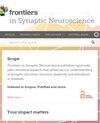社论:突触疾病:从生物学到潜在治疗
IF 4.1
4区 医学
Q2 NEUROSCIENCES
引用次数: 0
摘要
编码影响突触结构和/或功能的突触或突触相关蛋白的基因突变导致各种形式的突触病,包括神经发育、神经退行性疾病和精神疾病(Lepeta等人,2016;利马-卡尔代拉等人,2019;Bonnycastle等人,2021;Germann等人,2021)。几十年来,了解致病基因如何影响突触结构和功能,并导致电路和行为功能障碍,一直是神经科学研究的焦点。许多挑战仍有待解决,从鉴定罕见病相关基因,定义基因突变赋予疾病风险并表现为表型的分子和细胞机制,了解这些突变如何影响电路功能、可塑性和行为,到治疗干预是否可以恢复功能。研究突触通路的病理生理机制将有助于更好地理解控制正常神经系统功能的分子和细胞机制,并可能最终有助于发现有效的治疗方法(Wang和Doering,2015;Lepeta等人,2016;Lima-Calderira等人,2019;Carroll等人,2021)。本研究主题聚焦于研究常见突触病的进展,收集了31篇研究和综述文章,从对突触生物学基础的新见解到潜在的治疗策略。在这里,我们总结了每一篇文章,作为研究主题的指南,并强调了这项工作激发的许多新的研究问题。本文章由计算机程序翻译,如有差异,请以英文原文为准。
Editorial: Synaptic Diseases: From Biology to Potential Therapy
Mutations in genes encoding synaptic or synapse-related proteins that affect the structure and/or function of synapses are responsible for various forms of synaptopathies, including neurodevelopmental, neurodegenerative and psychiatric diseases (Lepeta et al., 2016; Lima Caldeira et al., 2019; Bonnycastle et al., 2021; Germann et al., 2021). Understanding how disease causing genes affect synapse structure and function, and cause circuit and behavioral dysfunction, has been a focus of neuroscience research over several decades. Many challenges remain to be addressed, from identifying rare disease-associated genes, defining the molecular and cellular mechanisms by which the genetic mutations confer disease risk and manifest as phenotypes, understanding how thesemutations affect circuit function, plasticity and behavior, to whether therapeutic interventions can restore function. Studying the pathophysiologic mechanisms underlying synaptopathies will lead to a better understanding of the molecular and cellular mechanisms that govern normal nervous system function, and may eventually help to discover impactful therapeutics (Wang and Doering, 2015; Lepeta et al., 2016; Lima Caldeira et al., 2019; Carroll et al., 2021). This Research Topic has focused on advances in studying common synaptopathies, collecting 31 research and review articles ranging from new insights into fundamental synapse biology to potential therapeutic strategies. Here we summarize each of these articles as a guide to the Research Topic, and highlight the many new research questions stimulated by the work.
求助全文
通过发布文献求助,成功后即可免费获取论文全文。
去求助
来源期刊

Frontiers in Synaptic Neuroscience
NEUROSCIENCES-
CiteScore
7.10
自引率
2.70%
发文量
74
审稿时长
14 weeks
 求助内容:
求助内容: 应助结果提醒方式:
应助结果提醒方式:


